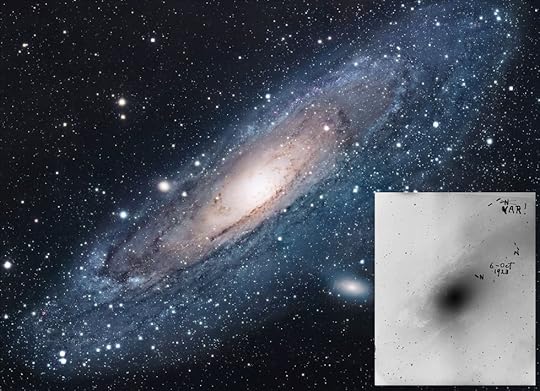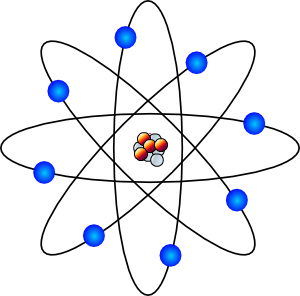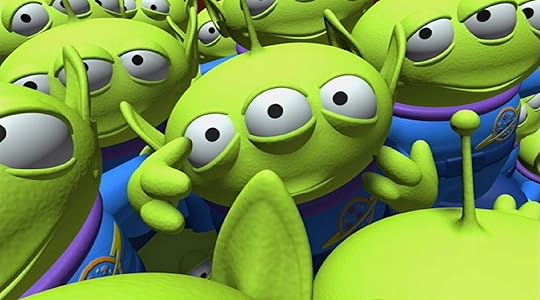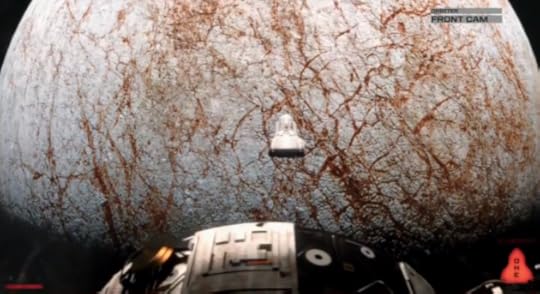Peter Cawdron's Blog, page 16
August 31, 2013
Little Green Men
As far as we know, there are no “little green men,” which is what makes them the ideal subject for my latest science fiction story: What if, against all probability, someone ran into our fabled little green men on some remote planet?
And no, not the sort of LGM you find in Toy Story, I mean the vicious tropes found in the classic science fiction of the 50s and 60s.
Some of the earliest uses of the term “little green men” come from the 1900s, when they were used to describe supernatural beings and “cloudland fairies.” Rudyard Kipling described gremlins as little green men in his 1906 novel Puck of Pook’s Hill, but it’s the association with extraterrestrial (and presumably intelligent) creatures that defines the modern imagery behind the concept of little green men.
In 1967, mysterious radio signals were picked up from deep space and jokingly referred to as LGM-1. The regularly repeating signal turned out to be from a natural source, a pulsar, a highly magnetized spinning neutron star emitting a beam of electromagnetic radiation in much the same way as a lighthouse does. But this light-hearted reference to Little Green Men highlights our cultural fascination with the prospect of contacting intelligent extraterrestrial beings.
Being a fan of the quirky science fiction stories of Philip K. Dick, I’ve penned a novella called Little Green Men that looks at the impossible scenario of finding these archetype aliens on another world. As is my want, the story mixes fact and fiction in a thrilling encounter that would not be out of place in The Twilight Zone.
 As much as I would have loved to use this brilliant cover design by Jason Gurley, the heart-thumping pace of the book demanded more sober tones.
As much as I would have loved to use this brilliant cover design by Jason Gurley, the heart-thumping pace of the book demanded more sober tones.
Here are some comments from the initial reviews on Amazon.
Things get interesting from the very beginning as crew members are attacked by, you guessed it, Little Green Men.
.
The story is wonderfully suspenseful, interspersed with some really good humor and with an ending that will leave you with your mouth hanging open! I could not stop turning the pages.
.
This is a terrific adventure story, full of bumps in the night and glowing eyes in the shadows… you won’t be able to put it down
.
The thing I love about Peter Cawdron’s writing is that it is atypical. It’s something I would have never thought of or have ever read else where. I enjoyed every page of this story
.
You can find Little Green Men for 99c on Amazon.
If you do read this story, be sure to leave a review as I’d love to hear your thoughts on it.


August 24, 2013
Robotics & Humanity
Here’s an interesting article about the history of robotics, reblogged from The Conversation via scitable
~~~
The truth is no stranger than fiction when it comes to robots
Robots represent the cutting edge in science. For decades we have been promised a bright future in which these human-like machines will become so advanced that we won’t be able to tell the difference between them and us. But are technologists really dabbling in the unknown in their work or merely ripping a page out of their favourite sci-fi novel?
Robots existed in fiction long before science made them a reality. In the 1920s, Czech playwright Karel Čapek wanted to create a character that could reflect the dehumanisation of society, the obsession with production and the jubilant celebration of technological progress that often resulted in the horror of the battlefields.
Having already experimented with using different non-human characters like newts and salamanders to reflect on human life and existence, Čapek made “the Robot” a central character in his play R.U.R. (Rossum’s Universal Robots). The Robot was a particular kind of “other” who looked and acted like a human being but lacked something unique – feelings. It was not the product of a mother and father but of a production line. For Čapek, it seems, the robot is an inherently political character, a revolutionary even.
But even this was not the first time that artificial beings had been used by creative writers. The cultural narrative of creation goes back to a time when humans first began to craft objects from material things. Some of these objects were shaped to look like humans. Take the Venus figurines that date back at least 35,000 years, or dolls, which have long been more than just innocent playthings for children in some cultures. Dolls can be magical talismans and, for some, the miniature representation of the human form was a useful way to control the human adult it was supposed to represent. The particular ways in which humans are represented is culturally specific but the desire to represent is, and always has been, universal.
So what is the modern technology of robotics doing that is so different from all these fictional exercises in imitating the human form? The roboticists and technologists of today would have you believe that their work is grounded in scientific reality when they seek the next big breakthrough in artificial intelligence. Cyberneticians and futurologists make claims as if the issues they address were never before considered in human society. But they are in fact more swept up in fantasy than ever before.
All attempts to represent the human form tap into a timeless motivation to know who we are: the mystery of life, reproduction, childhood and attachments to other humans, animals and nature.
What is exciting about AI and technology is that these provide new ways of representing the human form. But the debate about what that means is so confused and ridiculous at times it can leave futurologists lost in their own fantasies. In the 1960s, Marvin Minsky was so optimistic about the new field of AI, he believed that, by the end of the 20th century, machines will outsmart human beings. This is, in part, what inspired Arthur C. Clarke when he speculated about the future of intelligence in 2001: A Space Odyssey.
Ray Kurzweil is another case in point. In books such as The Singularity is Near: When Humans Transcend Biology, Kurzweil is forever predicting that we will merge with machines and be able to upload our “complete” consciousness into machines. This idea is emerging as the next big challenge in robotics but it could equally be viewed as a basic feature of human cultural existence.
I’m “uploading” my consciousness right now into this article. A visual artist, when she paints is also “uploading” her consciousness. Consciousness is just another way of saying psychic life – the life and impulses of the individual as a member of a family and collective. Arguably, any human being that has ever created anything has transferred aspects of their consciousness to artificial materials.
The fiction is now being created by the scientists. AI roboticists are given a free reign to project any fantasy they like about their technology and how it will irrevocably change what it means to be human. We have been asking the same question since the beginning of time in different ways. The only difference now is that those building the robots and AI systems believe their work is unique rather than part of an ongoing process and also stand to acquire a lot of money in the process.
~~~
I find it fascinating that the concept of robots arose out of the traumatic experience of battlefield technology in World War I, and in this regard there is a parallel with Lord of the Rings, which also drew on the horrors of that war for its grotesque, senseless violence. Like fire, technology is a wonderful slave, but a lousy master. And for Čapek, seeing technology so grossly abused in The Great War raised the question of “What next?” Could machines one day mimic and replicate humans, eventually replacing them? And that’s been a common theme in science fiction ever since.


August 9, 2013
Life in outer space
Is there life in outer space?
It may surprise you to realize that this is a question for which we already know the answer: Yes.
Earth is a wonderful example of how life can flourish and abound with astonishing diversity in the midst of the extremely harsh, radiation filled vacuum of space. And this highlights a perception flaw we have when considering life in outer space. We see Earth as distinct and separate from space, but it’s not, Earth is drifting through outer space. Earth is a brilliant example of how life can survive in space.
We live on a modestly sized planet orbiting a rather average star that is currently on the outer spiral arm of an unassuming spiral-barrelled galaxy. Space isn’t something out there somewhere away from us, we are in the depths of space.
Ah, so the question becomes… is there any other life in outer space?
The answer here is almost certainly yes as well, as although we haven’t found life, we have no reason to think that life doesn’t exist elsewhere. We have numerous reasons to think life abounds elsewhere in space. That we haven’t detected life is immaterial, and more a reflection on our inability to examine exo-planets in detail than anything else.
It is a poor sailor who never wants to see beyond the horizon – Plato
As for those who belittle SETI (the Search for Extraterrestrial Intelligence), one has to wonder what they would have said in the days of Christopher Columbus, or about the folly of Charles Darwin setting sail on the HMS Beagle? Exploration defines the quintessential character of humanity, as it is the only catalyst for learning. Whether it be exploring concepts in books or cataloging butterflies in a forest, whether it is a scientist looking for life on Mars or a young child looking for bugs beneath a rock, our curiosity defines us.
Horizons are immaterial. Horizons exist only from the perspective of the viewer. Horizons are an artificial boundary that can be probed and explored, and nowhere is that more true than in the search for life in space.
Astronomy is accelerating in its ability to expand our horizons. For hundreds of years, astronomers and philosophers like Immanuel Kant considered the idea of “island universes,” but it wasn’t until the 20th century that the notion of distinct galaxies emerged. Erwin Hubble took this image of Andromeda (inset) from the Mount Wilson Observatory. While the Hubble Space Telescope has given us this iconic image of Andromeda in astonishing detail and allowed us to view tens of thousands of galaxies stretching billions of years back in time.
 The Sloan Digital Sky Survey has mapped almost a million galaxies in a small slither of space, implying that the overall number of galaxies in the visible universe must be somewhere in the hundreds of billions. It is a poor soul indeed that would not want to see this magnificent universe examined in greater detail.
The Sloan Digital Sky Survey has mapped almost a million galaxies in a small slither of space, implying that the overall number of galaxies in the visible universe must be somewhere in the hundreds of billions. It is a poor soul indeed that would not want to see this magnificent universe examined in greater detail.
One question that comes up quite often is, “If there is life elsewhere, why haven’t we found evidence for ET?” Seth Shostak in his non-fiction book Confessions of an Alien Hunter, notes that if our galaxy was a haystack then we’re sitting on at least one needle in our solar system. With our efforts so far to examine the stars around us, we have conducted a thorough search of a spoonful of hay and arrived at the conclusion there are no other needles in our sample, but our sample is clearly not representative of the haystack as a whole.
 Extending the analogy further, scientists estimate there maybe as many as five hundred billion haystacks to consider, but we can only effectively examine one side of the haystack we’re in. We have no idea how many other needles there may be in our haystack, let alone how many needles there may be in all the other haystacks, but that haystacks have needles is beyond dispute as we’re sitting on one.
Extending the analogy further, scientists estimate there maybe as many as five hundred billion haystacks to consider, but we can only effectively examine one side of the haystack we’re in. We have no idea how many other needles there may be in our haystack, let alone how many needles there may be in all the other haystacks, but that haystacks have needles is beyond dispute as we’re sitting on one.
When it comes to life in outer space, we’ve got to remember that time is a factor as well.
Take a look at this planet. Do you think it could support life?
Because this is what Earth probably looked like during the Hadean eon shortly after the planet formed. Tectonic plates formed a thin crust over the planet. Due to the extreme pressure of the predominantly C02 laden atmosphere, a liquid ocean formed at a scalding 440-500F (beyond 230C). The newly formed Moon orbited at a fraction of the distance it does today, causing massive tidal waves hundreds of feet high to sweep the planet every four hours.
As Earth cooled, it was subject to the Late Heavy Bombardment with tens of thousands of meteor impacts reaching 12 miles in diameter (20km), roughly forty massive impacts left craters in excess of 600 miles in diameter (1000km), and there were a few whoppers that carved out basins 3000 miles in diameter, that’s roughly the distance from New York to Salt Lake City. And yet, somehow, in the midst of Dante’s inferno, life arose.
What would we have made of Earth if we’d spotted her from afar with the Kepler space telescope at this time? Would we have suspected that the simplest of microbes were already arising amidst this seething hell?
How about this world?
Could this world hold life?
 Because as best we understand the evidence, Earth went through several “snowball” periods over the past few billion years. Each of them came perilously close to extinguishing life on Earth.
Because as best we understand the evidence, Earth went through several “snowball” periods over the past few billion years. Each of them came perilously close to extinguishing life on Earth.
Our planet is 4.4 billion years old. For at least 3.8 billion years there’s been life on Earth, which is a staggering fact when you stop and consider that the universe itself is only 14+ billion years old. For just under a third of the time the universe has existed, there has been life on Earth! And on Earth, life has endured seemingly insurmountable odds to survive for over 80% of the planet’s history. These are particularly heartening facts when we consider our search for life elsewhere.
We may only have one confirmed example of life in outer space, but it is spectacular in its longevity, its tenacity and its diversity. We have no reason to think the same process hasn’t been replicated elsewhere throughout the universe.


July 14, 2013
Europa Report
I thoroughly enjoyed the Europa Report. Here’s an overview, spoiler free.
Europa Report is a film about the first spaceship to leave the Earth-Moon system, travelling to Europa to search for signs of life.
There’s a few minor issues with the film (like digging through three kilometers of ice only to walk a hundred yards and find the ice is wafer thin), but compared to Transformers or Battleships, this movie is scientifically plausible.
Be warned, the movie unfolds in chaotic flashbacks that confuse the story a little, so you’ve really got to keep track of the dates that pop up on the screen. I’m not sure why the producers went with this format, as a chronological sequence would have worked well and wouldn’t have spoiled anything. Given the style is that of a documentary, the story would have been better served in a continuous format.
Europa Report unfolds from the perspective of various internal cameras fixed within the craft as well as from the odd helmet cam, and the initial pacing of the movie is very “Big Brother” (ie, it’s a bit like watching a reality TV show about nothing), but that lends to the verisimilitude of the story and places the audience along for the ride. You get a good feel for life in a tin can and the sense of isolation the astronauts feel, not to mention the claustrophobia of never being alone.
After a sedate opening thirty minutes and a number of breathtaking shots of the spacecraft at various points on its journey, tension starts to mount and the story ratchets up to a climax that feels ominous. This is an independent science fiction movie and it shows in that there’s none of the classic Hollywood tropes and cliches. If you want to see Will Smith punching aliens and chewing a cigar, this is not the movie for you. If you want something that’s a little rough around the edges, but leaves you thinking, you’ll enjoy Europa Report.
Europa Report is available using VOD from iTunes and the Google Play store, but if you’re outside the US you may want to use a proxy service or you won’t be able to find it (groan).
5/5 Stars from me.


July 13, 2013
Independent science fiction
Independent science fiction is the shape of things to come.
Don’t get me wrong, I’m not in any way bagging writers that have agents, editors and publishers, as they help refine the quality and presentation of a novel/movie, but independent science fiction has a raw, gritty value that shouldn’t be underestimated.
As an example, recently, someone sent me a link to a podcast about the dire state of Hollywood, and why the only movies coming out at the moment are:
Blockbusters (or blockbuster wannabes like The Lone Ranger)
Franchises (Fast & the Furious 64)
Token art-house films as candidates for the Oscars
Hollywood has been backed into a corner. Costs are so high, the risk of failure so great, that no studio can afford to take a chance on a novel, unique concept. Safe movies are the only winners. And it’s a vicious cycle, Hollywood is trapped in a self-fulfilled prophecy, that no other movies can succeed. They’re wrong, of course, as demonstrated by independent movie producers.
Essentially, the movie industry has been out-played. All forms of entertainment are in the throes of going virtual: The music industry was overhauled by Napster and iTunes, while the publishing industry is in the process of being transformed by Amazon and the popularity of eBooks. Hollywood has held onto its cinema empire, but the advent of VOD (video on demand), which bypasses theatrical releases altogether, means the writing is on the wall: The End is Nigh.
Hugh Howey and Matthew Mather have both sold movie rights to their books, and I hope their books are made into movies as I’ve thoroughly enjoyed both Wool and CyberStorm, but given that the slow torturous process of transforming a novel into a screenplay and producing a film can take a decade, I wonder how much the Hollywood landscape will have changed by then.
In the same way indies are taking the publishing market by storm, I wonder if we’re going to see Hollywood undermined by independent movies. The term “low budget” no longer describes cheap B-grade movies but rather slick, lean, high-quality productions without any of the Hollywood bloat we’ve seen in movies like Battleships.
Already, movies like Monsters and Europa Report are blitzing Hollywood in terms of story depth and suspension of disbelief. We’re at a tipping point. Going forward, Hollywood is going to become more and more alienated in much the same way as music stores and bookstores have staggered under pressure from iTunes and Amazon. Hollywood is going to have to adapt to survive.
From a writer’s perspective, competition is good, it drives innovation and resourcefulness.
In some regards, books struggle to compete against movies, TV, games, social media, etc, as these other mediums are more directly engaging, but the strength of books is their ability to immerse you in an entirely different world.
The level of immersion in a book is beyond what can be achieved by these other mediums. As an example, I’m currently working with scifi-publishing to convert my dystopian novel Monsters into an audio-book. Initial estimates suggest it will come in around 10 hours in length, and having listened to two samples I’m already blown away by how the narration captures the subtleties a movie would be hard pressed to match.
The other advantage writers have is they’re not constrained by budget. My CGI budget is a bazillion dollars. I can do anything I want, ANYTHING, and I often do. In my latest novel, Xenophobia, there’s tens of thousands of grotesque alien creatures floating through Earth’s atmosphere, bizarre spiky aliens that can shred a man in seconds, and a mothership the size of Connecticut. As exciting as it would be to see one of my novels turned into a movie, books are an awesome medium and not to be underestimated because they tap directly into the imagination of the reader.
Maybe one day Monsters or Xenophobia will be available as independent movies, but even then I doubt they’ll ever compete with the books and audio-books for depth.


June 22, 2013
What are you afraid of?
For the most part, we have a pretty good grasp of the things that make us afraid, such as a scary movie or a bump in the dark of night, but it’s the subtle fears we easily overlook that are the most pervasive, these fears are often held without any conscious recognition.
My latest novel, Xenophobia, examines these fears in the context of first contact with an extraterrestrial intelligence. Sure, there’s the usual, obvious invasion fears, but the emotions I wanted to examine are the subtleties associated with human behaviour, like the fear of being wrong, the fear of change, and of course, the fear of strangers – xenophobia. And it’s these unspoken fears we often fail to realize in ourselves.
Fear seems pretty obvious. Ride a roller-coaster and you’ll feel your heart thumping because your senses are being assaulted with potentially life-threatening speeds, thrills and spills, but it’s the fears associated with social interactions that are often obscured by rationalisation and pride. Instead of being engendered by a need for self-preservation, these more subtle fears are rooted in our instinctive, tribal nature.
Reason is the only cure for fear.
Xenophobia is set against the harsh reality of life in Africa. Malawi is on the verge of civil war. UN soldiers maintain a fragile peace. When an alien spacecraft moves into orbit near the Moon, the US withdraws its troops and Africa descends into chaos…
Jae Lee, a US graphic design artist working in Germany has graciously provided the artwork for Xenophobia. If you’re interested in reading Xenophobia, the first few chapters can be downloaded for free.
Xenophobia as a mobi file for Kindle
 You can find Xenophobia on Amazon and Smashwords.
You can find Xenophobia on Amazon and Smashwords.


June 10, 2013
Iain M Banks
Death is always tragic, always a waste. Cancer is particularly cruel, stealing life with no rhyme or reason.
For the legendary science fiction writer Iain M Banks, who died yesterday at the age of 59, a sore back in January of this year turned out to be terminal gall bladder cancer.
The gall bladder is a small organ that aids in the digestion of fat, concentrating bile produced by the liver. It’s sad to realize that an organ Iain could have easily lived without could turn cancerous and cause his death. Had the initial tumor been caught before the cancer spread, the entire organ could have been removed with little or no impact on his quality of life. Heartbreaking.
Ever the writer, Banks has left a legacy of dozens of books, including his final novel, The Quarry.
Banks uses The Quarry as a means of dealing with his own mortality, describing cancer as “betrayal” by one’s own body, an “unwilling suicide.”
I know… cancer is not contagious. You can’t catch it off him. That’s the thing about cancer. It’s all yours – it’s entirely, perfectly personalised.
And these thoughts echo those of the medical community, looking to personalize treatments for cancer.
Cancer is not a disease in the colloquial sense of the word being something external you can catch, like an infection. Cancer is a failing, a defect.
We look at ourselves as individuals, but we’re composite creatures, comprised of numerous specialty cells forming organs dedicated to certain life-giving functions. From one day to the next, we see ourselves as largely static. Sure, you need a haircut every now and then, or you need to trim your nails, but you are you, right? Wrong. You are Ye (old English plural). You are a dynamic entity of trillions of living cells, cells that are constantly dividing and replenishing themselves.
And the irony is, these cells are programmed to die. At first, you might think that’s a bad thing, but it’s not. Cells die all the time so you and I can live. It’s when cells don’t die that we run into problems. When cells don’t die, they multiply uncontrollably and, in essence, that’s what cancer is, unregulated growth. Growth that eventually kills its host by overwhelming other life-supporting organs.
In writing The Quarry, Iain Banks gave us a first-hand account of something none of us ever want to live through, and in that regard he has done us a service. He repudiates the notion of “alternative treatments.” Tylenol is an alternative to Ibuprofen. Fentanyl is an alternative to Morphine. Vitamin C is not an alternative to chemotherapy.
Banks understood the temptation for cancer patients to grasp at straws, but his rational mind demanded scientifically-proven, evidence-based medicines. The temptation is to try everything, after all, it can’t hurt, right? Wrong. Research has shown “herbal remedies” like St. John’s Wort, garlic, vitamin E and Echinacea disrupt the effectiveness of some chemotherapy drugs. And so, Iain Banks was determined to use his influence to drive home the importance of good science in his last work of fiction.
In the words of Scottish MP Alex Salmond.
Iain won many admirers with the humour and forbearance he showed in dealing with his illness.
His determination not just to complete his final novel but also to reflect his illness in the pages of his work, will make that work all the more poignant and all the more significant.
Farewell, Iain.


June 6, 2013
Reaching for the stars
In 2012, the U.S. Defense Advanced Research Projects Agency (DARPA) and NASA announced the 100 Year Starship, a project to develop a spaceship capable of achieving interstellar flight within the next hundred years.
With the backing of two of the top US research groups, the 100 Year Starship has credibility and has inspired scientists to revive ideas like the Daedalus, a 1970s concept spacecraft developed by the British Interplanetary Society. The Daedalus was an ambitious concept, using the propulsion provided by detonating/fusing nuclear pellets to accelerate the craft to 12% of the speed of light and cover the 5.9 light years to Barnard’s Star in 50 years. Daedalus was to be the start of mankind’s journey to the stars.
Recently, the Starship Congress put together a kickstarter campaign for a summit of scientific minds to consider Icarus, a variation on the Daedalus concept.
Projects like Daedalus and Icarus raise a number of questions:
How realistic is it to undertake such an ambitious endeavour?
In 1865, as Jules Verne wrote From Earth to the Moon, the United States was coming to the end of four years of bloody civil war. Muskets and cannons, horse-drawn carts and steam boats marked the extent of technological development. The idea of sending someone to the Moon was more than ludicrous, as no one had any idea what such a journey would actually entail. Just a few decades earlier, the the Great Moon Hoax had deceived the nation into thinking man-bats and unicorns inhabited the Lunar surface. Flying to the Moon was nothing more than fantasy.

Although his writing was fictional, Verne applied his mind to the problem of a lunar journey and came up with some good, plausible ideas given the age in which he lived.
Verne understood the need for an enclosed spaceship. He suggested an aerodynamic capsule fired from a cannon with multiple charges placed along the huge muzzle so as to ensure the capsule reached escape velocity. The Nazi’s later picked up on this idea when trying to build a cannon capable of shelling London from France.
Verne understood that such rapid acceleration would be fatal to any occupants and so devised an ingenious method of cushioning his astronauts.
 Verne proposed an inner casing/capsule resting on several collapsable wooden floors with water in between (seen depicted in this sketch). As the capsule accelerated, each floor would give way, and the water would act as a baffle, cushioning the astronauts. For its time, it was an innovative idea, a stepping stone, a catalyst that would inspire others to look for solutions to the numerous problems that arose around such an undertaking.
Verne proposed an inner casing/capsule resting on several collapsable wooden floors with water in between (seen depicted in this sketch). As the capsule accelerated, each floor would give way, and the water would act as a baffle, cushioning the astronauts. For its time, it was an innovative idea, a stepping stone, a catalyst that would inspire others to look for solutions to the numerous problems that arose around such an undertaking.
Remarkably, just over a hundred years later in 1969, Neil Armstrong and Buzz Aldrin walked on the Sea of Tranquility, transforming Verne’s science fiction into science fact.
In the same way, the 100 Year Starship seeks to tackle the problems associated with interstellar travel. Sure, some of the ideas may be akin to Verne’s water baffles, but they’re progressive, forward thinking.
A good friend of mine in Sydney builds custom, remote-control model airplanes. If I told him I had a plane that could barely fly 120 feet and struggled to get over 10 feet in altitude, staying aloft for a mere 12 seconds before skidding to a halt, he’d tell me to go back to the drawing board as his planes zip around the sky hundreds of feet in the air, performing astonishing acrobatics, and yet those are the stats of the Wright Brother’s first flight.
And this highlights an important point about the 100 Year Starship, baby steps are valid steps. No matter how small, progress is progress. Given mankind has been around as a species for the best part of 200,000 years, look at how far we have come in the last 100. A mere 120 feet at Kitty Hawk has grown to hundreds of thousands of airplanes traveling around various parts of the world every day, crossing continents, spaning oceans, providing transportation, fighting forest fires, you name it. The rate of progress from that cold, windy day at the beach in December of 1903 has been astonishing.
So are the efforts of the Starship Congress beneficial? Absolutely.
Why reach for the stars when we’re still struggling here on Earth?
This is an interesting question, and one I discuss at length in the novel Galactic Exploration, but perhaps the best answer is that provided by T.S. Elliot.
We shall not cease from exploration
And the end of all our exploring
Will be to arrive where we started
And know the place for the first time…
Historically, exploration has been undertaken for a raft of reasons, from seeking economic opportunities to colonizing new lands and pursuing ideals, but from a scientific perspective, exploration is a means of learning.
Although it’s been over forty years since man walked on the Moon and our visions of a colony on Mars look remote, the past few decades have been dominated by exploration, only the exploration we’ve undertaken has required nothing more than a satellite-mounted telescope or a remote control rover. From Hubble to WMAP and the Galaxy-B Probe, we’ve been exploring the most remote corners of the universe from here on Earth. And as T.S. Elliot noted, we have learnt more about ourselves and our planet in the process.
Science answers questions. Science can be summarised in one word, why? Science is more than curiosity. Cats are curious, but they never learn. Science is founded on learning about the natural universe around us.
Why reach for the stars while there are millions suffering and starving on Earth? Because mankind’s strength comes from understanding. The more we learn and understand about this remarkable universe, the more we can influence the course of our lives and those of our fellow men and women.
Looking back at Kitty Hawk, that first powered flight seemed little more than a novelty, an endeavour that held some academic interest but little in the way of real benefits, and yet look at how far we have come, look at how flight has transformed our world. In the same way, the Starship Congress is consolidating the best thinking in numerous related fields to build a foundation for the future.
Traveling to other stars may be the realm of science fiction today, but tomorrow fiction will become fact. By undertaking this endeavour, we’re not ignoring the problems that plague our planet, we’re advancing a solution.
We reach for the stars so we need not remain in the gutter.
Every great advance in science has issued from a new audacity of imagination
John Dewey
~
So get behind this awesome kickstarter project


Electrons & Protons
 I remember asking my high school chemistry teacher why the curriculum covered Bohr’s solar-system-like model of the atom that we’re all so familiar with but never ventured into the more accurate quantum model.
I remember asking my high school chemistry teacher why the curriculum covered Bohr’s solar-system-like model of the atom that we’re all so familiar with but never ventured into the more accurate quantum model.
Our conversation went something like this… ”Quantum mechanics is too complicated, it will only confuse students.”
To which I replied, “How do you know that? How do you know you’re not confusing them by not teaching a more accurate model? Perhaps the Bohr model is inadvertently misrepresenting the situation and making it more difficult than it ought to be.”
He countered with, “It’s too hard to picture electrons as a wave and probabilities collapsing into a particle.”
“Like rain condensing from a cloud?” I replied, “Or drops of water forming on a window when it’s foggy outside?”
And that’s the thing about quantum mechanics, sure it’s difficult to understand, but it’s made even harder by the insistence that it is too difficult. Instead of giving up on public understanding, we should be looking at ways to make this remarkable field of science easier to grasp.
Have you ever played with a slinky spring? Or have you held a skipping rope with a friend and shook it up and down to form a standing wave? If so, you have a practical understanding of what waves are and how they perpetuate, and that’s a good place to start when considering subatomic particles.
Atoms are made up of electrons, protons and neutrons.
In the simplistic Bohr model, -ve electrons orbit the +ve protons and neutrons in the nucleus, but the obvious question that arises is, why don’t these negative electrons spinning around positive protons collide and form lots and lots of neutrons? In other words, why to electrons and protons exist at all? Why haven’t they collided to cancel each other out and form neutrons?
It’s a good question, because according to classical physics, electrons should collide with protons to form neutrons. That they don’t was a significant clue that lead to our modern understanding of quantum mechanics.
I put this question to a friend of mine, scientist and fellow science fiction writer, Brian Wells. Here’s his response…
There are two answers to this question.
PARTICLE ANSWER:
It’s the electron/proton pair merging to form a neutron that is the culprit. At least when thought of in “particle form.” You’d think that, just like gravity, attractive charge would make two objects collide under circumstances that should be fairly common (like when they’re heading right for one another). However, when gravity makes things collide, you end up with exactly the same mass/energy you started with (if Earth is struck by an asteroid you end up with Earth plus the asteroid).
But when a proton and electron collide, they don’t form a neutron because neutrons are a bit heavier than the proton and electron you started out with. So for a proton and electron to collide and “stick,” there has to be energy added and converted into mass in order to form the resultant neutron. And even at the levels we’re talking about, that’s a LOT of energy.
Earth + asteroid === asteroid mushed into Earth
Proton + electron =/= neutron (as a neutron is more than simply a proton & electron stuck together)
When neutrons decay, which they do all the time when not bound in a nucleus, they don’t simply form a proton and an electron, they form a proton and and electron and a whole bunch of energy.
Ah, but we also have the electron’s added relativistic mass to work with, right? So how much mass does the electron need to add in order to have the necessary heft to form a neutron with a proton? Alas, it turns out that an electron must increase its mass by 250%, which is unlikely under any circumstance.
Of course, this raises the question: are the electrons colliding with the nucleus and just bouncing off because they have neither the mass nor the energy to form a neutron with the proton they’re colliding with? Or is something else at play?
Okay, short answer: something else is probably at play. Get ready for it… wait for it… wait…
WAVEFORM ANSWER:
It seems electrons in the inner shell form a charge around the nucleus that prevents electrons (even from within the inner shell) from reaching the nucleus. It’s like a stone arch — every stone wants to fall to the ground, but the pressure of the surrounding stones prevents any of them from falling.
But what about a simple hydrogen atom, you ask? How can you have an arch made of just one stone? Again, quantum mechanics. In wave form, the single electron forms a quantum probability cloud around a hydrogen nucleus, thereby suspending itself, effectively causing the single orbiting electron to interfere with itself and prevent itself from falling, just as a single photon of light interferes with itself in a double-slit experiment. It’s a case of strange, but true.
And scientists have just this week imaged the single electron “orbiting” a hydrogen atom. As the theory predicts, the electron exists as a wave surrounding the nucleus.


June 2, 2013
Relativity & chemistry
Apologies in advance for this overly verbose post, but it shows how something as mundane as starting your car hinges upon relativity. I hope this post doesn’t put you to sleep, or worse, make your eyes bleed, but I think it’s worth the journey to understand a little more about the physical universe in which we live.
Relativity is counterintuitive to us because we never directly, knowingly experience relativistic effects, and yet those effects are all around us.
Take a 12V lead battery as an example. Roughly 10 of those 12 volts we take for granted occur because of relativistic effects, which is surprising. In other words, relativity is much more commonplace than we first thought, and it’s worth understanding why.
First a little high school chemistry recap… Elements in the periodic table are listed in order of their atomic number (which is the number of protons in the nucleus of an atom). Elements are grouped or stacked “periodically” meaning according to shared/similar chemical properties.
Look at tin (Sn) and lead (Pb), they’re in the 14th column, rows 5-6.
Tin (Sn) has 50 protons so it’s atomic number is 50, while Lead sits directly below Tin, having 82 protons.
The columns in the periodic table represent the number of electrons in the outer shell of each particular element. Although all these elements have a different total number of electrons, those in the same column have the same number of outer electrons, and so have similar chemical properties.
Why is this important? Well, when it comes to our lead battery, in theory we should be able to make batteries out of tin as well as lead. After all, they’re chemically very similar. The problem is… in practice we can’t. And this inconsistency got scientists thinking, wondering why there would be such a stark difference between two elements that are chemically so similar.
The answer is… relativity.
Opposites attract, so electrons (-ve) “orbit” protons (+ve). Actually, electrons don’t swing around the protons at the heart of an atom like a planet orbiting the sun, they frequent a probabilistic cloud, but for our purposes we’ll talk of them orbiting.
Now, the larger atomic number, the more +ve protons there are in the atom’s nucleus. Remember, tin has 50 protons, lead has 82, so lead has considerably more positive charge attracting negative electrons. And here’s where relativity kicks in. With so much charge, the negative electrons whizzing around such a large positive charge travel at 60% of the speed of light, and as Einstein showed with E=mc2, that blistering speed means these more energetic electrons are more massive that those orbiting the nucleus of a tin atom!!!
Think about water rushing down a hole. The larger the hole, the more water can flow through. Water falls into the newly-formed well around the hole. In the same way, protons form an energy well. The more positive protons there are at the heart of an atom, the faster they draw in electrons, only unlike water, the electrons never reach the protons, they get trapped swirling around them in a cloud.
And this is where relativity comes into play, our electrons are moving so fast their mass increases and they drop deep within this energy well. So when they’re released in a chemical reaction, the electricity that’s liberated is significantly more for lead than for tin (deeper well = faster electrons = more energy).
In science fiction, we’re used to hearing about the speed of light as a limit on spaceships traveling between stars, but the speed of light is intricately tied into the very fabric reality, having a significant impact on chemistry.
The chemical properties of heavy elements are not just determined by their charge but by the speed with which electrons orbit their nucleus, and that’s a surprising insight.
Are you married? Do you have your wedding ring on? The gold in your wedding ring has that beautiful shine because the electrons whizzing around the nucleus are racing along at over half the speed of light! As with lead, the insanely fast outer electron hurling “around” the gold nucleus causes this element to behave differently to those lower on the periodic table.
With one electron in its outer shell, we’d expect gold to be highly reactive, like other elements that have only one outer electron. Lithium, sodium, potassium, copper, silver, etc are all highly reactive, tarnishing in the air and in some cases exploding on contact with water, and yet gold doesn’t share this behaviour even though strictly it should. Gold is renown for being inert. Why? Relativity.
That one outer electron is buzzing around so fast its mass has increased by 20% causing it to fall inward and almost join the next inner shell of electrons, making gold impervious to chemical reactions.
All this brings up an interesting point, if the speed of light were lower, chemistry would change. If the speed of light were half what it is, elements like uranium could not exist, gold and lead would be highly radioactive and unstable like uranium and plutonium, while elements like potassium or copper would take on the properties of gold.
So next time you put on your wedding ring or start your car, remember you’re interacting with elements that only exist as they do because of relativity.
Pretty trippy, huh?



























